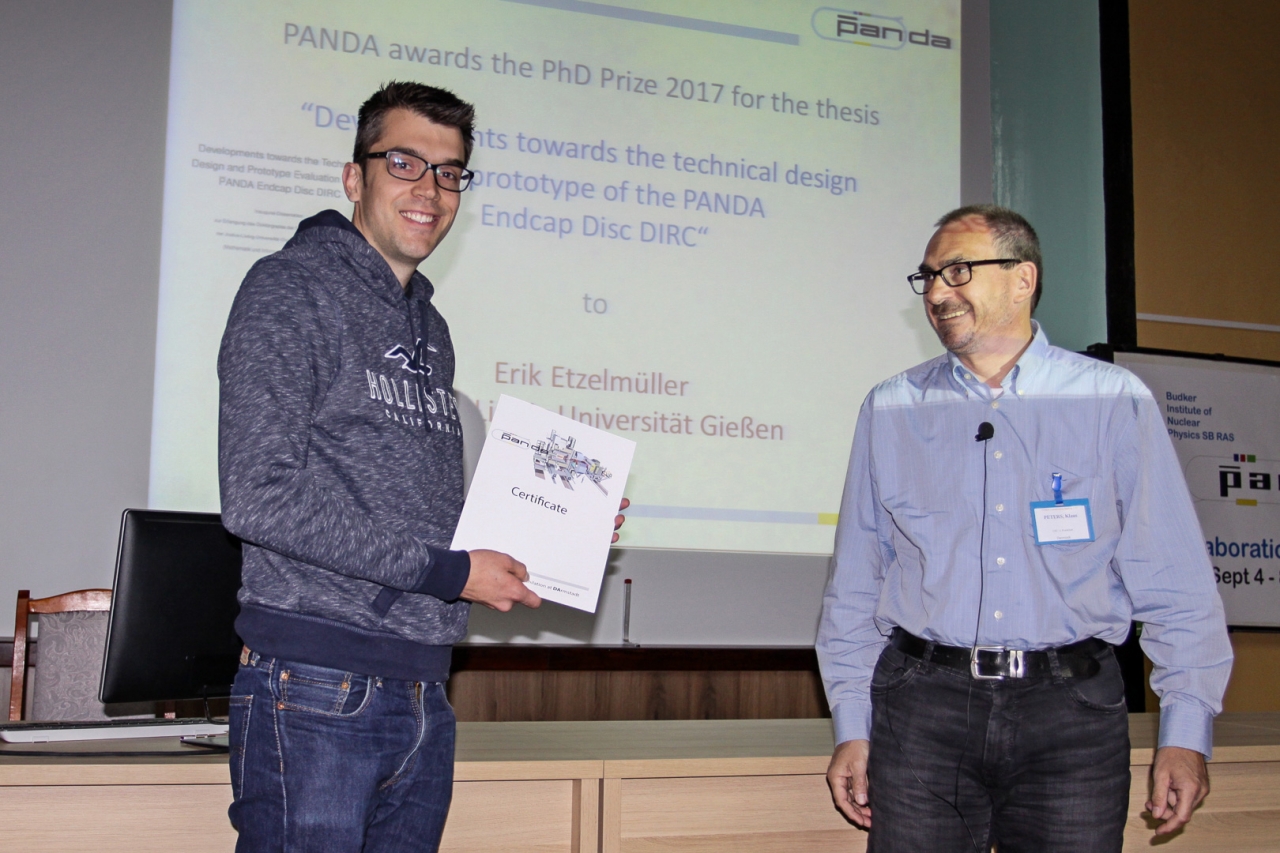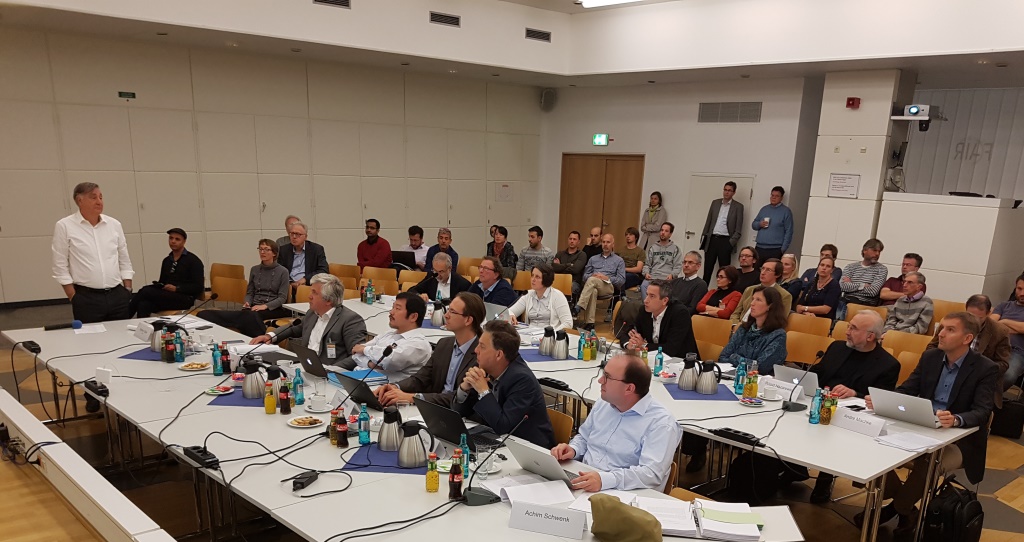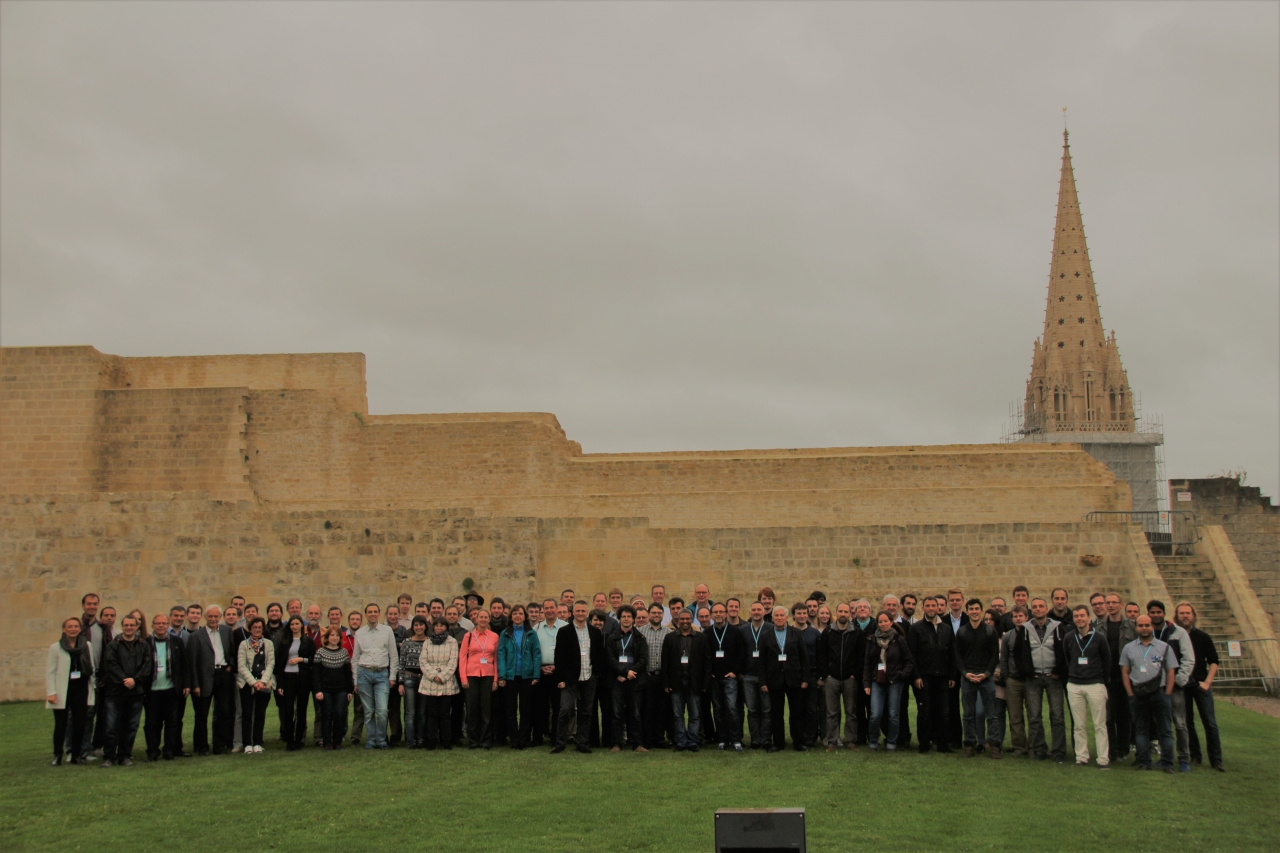Sie sehen momentan nur den öffentlichen Teil des GSI-Kuriers.
Um auch die GSI-internen Artikel angezeigt zu bekommen,
melden sie sich bitte an

Kurier - Mitteilungen von und für Mitarbeitende
Ausgabe: 40-2017 | 02.10. - 08.10.
Nachrichten
- Markus Steck erhält Dieter-Möhl-Medaille
- Panda-Kollaboration zeichnet Doktoranden aus: PhD-Preis für Dr. Erik Etzelmüller
- Program Advisory Committees für FAIR Phase-0
- 14. SPARC Topical Workshop, Campus GANIL, Caen, Frankreich, 11. – 14. September 2017
- GSI Scientific Report 2016 / GSI Report 2017-1
- Interne Stellenauschreibungen
Nachrichten
Markus Steck erhält Dieter-Möhl-Medaille

Die diesjährige Dieter-Möhl-Medaille für bedeutende Beiträge zur Strahlkühlung und deren Anwendung geht an Dr. Markus Steck, den Leiter der GSI-Abteilung "Speicherringe". Er erhielt den Preis für seine führende Rolle in der systematischen Untersuchung der Elektronen- und der stochastischen Kühlung bei GSI, die zur erstmaligen experimentellen Beobachtung von geordneten Ionenstrahlen führte. Die Medaille wurde im Rahmen der wissenschaftlichen Konferenz COOL17 am 22. September 2017 in Bonn durch den Vorsitzenden des Programmkomitees, Gerard Tranquille vom europäischen Forschungszentrum CERN, übergeben. Weiterer Preisträger war Takeshi Katayama von der Nihon-Universität, Japan.
Die Medaille wurde nach dem Tod von Dieter Möhl im Jahr 2012 von CERN gestiftet. Der Preisträger wird durch ein Auswahlkomitee bestimmt. Die Medaille wird alle zwei Jahre anlässlich der COOL-Konferenz verliehen. Der Namensgeber Dieter Möhl war über viele Jahre bei der Planung neuer Beschleunigeranlagen bei GSI in Komitees und als Berater unterstützend tätig. Nach seiner Pensionierung hatte er zusammen mit Takeshi Katayama die Planung der Speicherringe und insbesondere die Auslegung der Strahlkühlungs-Systeme bei FAIR durch seine Beratung mit wichtigen Beiträgen unterstützt.
Foto: G. Otto
Markus Steck receives Dieter Möhl Medal
This year's Dieter Möhl Medal for achievements in and contributions to the field of beam cooling and applications goes to Dr. Markus Steck, head of the GSI department "Storage Rings". He received the award for his leading role in the systematic studies of electron and stochastic cooling at GSI leading to the first experimental observation of ordering in an ion beam. The medal was handed over by the chairman of the programme committee, Gerard Tranquille of the European research center CERN, on September 22, 2017 in the framework of the COOL17 conference in Bonn, Germany. Takeshi Katayama of Nihon University, Japan, also received the award.
The medal was sponsored after the death of Dieter Möhl in 2012 by CERN. The awardee is chosen by a selection committee. The medal is awarded every two years during the COOL conference. Name patron Dieter Möhl supported the planning of new accelerator facilities at GSI in committees and as advisor for many years. After his retirement he provided important contributions to the planning of the FAIR storage rings and especially the design of their beam cooling systems with his counsel.
Öffentlichkeitsarbeit
Panda-Kollaboration zeichnet Doktoranden aus: PhD-Preis für Dr. Erik Etzelmüller

Quelle: BINP, Novosibirsk
Dr. Erik Etzelmüller (links) hat für seine Promotionsarbeit bei GSI und FAIR sowie an der Justus-Liebig-Universität Gießen den Panda PhD-Preis 2017 erhalten. Übergeben wurde die Auszeichnung beim jüngsten Panda-Kollaborationstreffen am BINP in Novosibirsk durch den Sprecher der Panda-Kollaboration, Klaus Peters von GSI.
Der 30 Jahre alte Physiker Erik Etzelmüller hat den Preis, der mit 200 Euro Preisgeld sowie einem Zertifikat dotiert ist, für seine Dissertation zum Thema „Developments towards the technical design and prototype of the PANDA Endcap Disc DIRC“ erhalten. Betreuer der Promotion war Professor Dr. Michael Düren von der Justus-Liebig-Universität Gießen.
Der PhD-Preis wird seit 2013 einmal jährlich von der Panda-Kollaboration für die beste Dissertation verliehen, die im Rahmen des Panda-Experiments erstellt wurde. Panda ist eines der Schlüsselexperimente am künftigen Beschleunigerzentrum FAIR, im Mittelpunkt stehen die Forschung mit Antimaterie sowie verschiedenen Themen rund um die schwache und die starke Kraft, exotische Zustände von Materie und die Struktur von Hadronen. In der Kollaboration arbeiten mehr als 500 Wissenschaftler aus 17 Ländern zusammen. Dr. Erik Etzelmüller beschäftigt sich in seiner Dissertation mit einem Cherenkov Detektor auf Basis der DIRC Technologie als wichtigem Bestandteil des Panda-Detektors, der an der FAIR-Beschleunigeranlage zur der Identifikation geladener Teilchen aufgebaut wird.
Kandidaten für den PhD-Preis werden von ihrem jeweiligen Doktorvater nominiert, Voraussetzung ist neben einem direkten Bezug zur Panda-Forschung die Bewertung der Promotion mit mindestens „sehr gut“. Bis zu drei Kandidaten kommen in die engere Auswahl und dürfen ihre Arbeit beim Panda-Kollaborationsmeeting präsentieren. Die Entscheidung erfolgt durch ein von der Panda-Kollaboration benanntes Komitee. Mit dem PhD-Preis möchte die Panda-Kollaboration die Beiträge von Studenten zum Panda-Projekt besonders würdigen.
Panda Collaboration honors PhD: Prize for Dr. Erik Etzelmüller
Dr. Erik Etzelmüller (left) has received the Panda PhD Prize 2017 for his doctoral thesis at GSI, FAIR, and the Justus Liebig University in Giessen. The award was presented by the spokesman of the Panda Collaboration, Klaus Peters from GSI, at the most recent Panda Collaboration meeting at the BINP in Novosibirsk.
Physicist Erik Etzelmüller, 30, received the prize of €200 and a certificate for his dissertation titled Developments towards the technical design and prototype of the PANDA Endcap Disc DIRC. His doctoral advisor was Prof. Dr. Michael Düren from the Justus Liebig University in Giessen.
The Panda Collaboration has awarded the PhD Prize once per year since 2013 in order to honor the best dissertation written in connection with the Panda Experiment. Panda will be one of the key experiments of the future accelerator center FAIR. The experiment focuses on antimatter research as well as on various topics related to the weak and the strong force, exotic states of matter, and the structure of hadrons. More than 500 scientists from 17 countries currently work in the Panda Collaboration. In his dissertation, Dr. Etzelmüller studied die Endcap Disc DIRC, a Cherenkov detector that forms one of the main components of the charged particle identification of the Panda detector, which is being built at the FAIR accelerator facility.
Candidates for the PhD Prize are nominated by their doctoral advisors. In addition to being directly related to the Panda Experiment, the nominees’ doctoral degrees must have received a rating of “very good” or better. Up to three candidates are shortlisted for the award and can present their dissertations at the Panda Collaboration meeting. The winner is chosen by a committee that is appointed for this task by the Panda Collaboration. The Panda Collaboration awards the PhD Prize to specifically honor students’ contributions to the Panda project.
Prof. Klaus Peters for the PANDA collaboration
Program Advisory Committees für FAIR Phase-0

Quelle: privat
Nachdem der ‘Call for Proposals’ für die FAIR Phase-0 im Frühjahr veröffentlich worden war, wurden fast 150 Strahlzeitanträge von über 1000 Wissenschaftlerinnen und Wissenschaftlern aus aller Welt an das General Program Advisory Committee (G-PAC) und die drei sub-PACs PHELIX Committee, Mat-PAC und Bio-PAC eingereicht. Darin beantragten die verschiedenen Forschergruppen Strahlzeit für den Zeitraum 2018/2019, um die für FAIR verbesserten Beschleunigeranlagen von GSI, den FAIR CRYRING Speicherring und erste FAIR Detektoren in einem intermediären Experimentierprogram zu verwenden. Während des G-PAC Meetings stellten die Sprecher ihre Anträge in öffentlichen Sitzungen mit lebhaften Diskussionen vor. Die Advisory Committees begutachteten die Anträge und sprachen Empfehlungen zur Genehmigung von Experimenten von höchstem wissenschaftlichem Interesse aus.
Wir freuen uns nun auf den erfolgreichen Start von FAIR Phase-0 mit zahlreichen Experimenten der Spitzenklasse!
Program Advisory Committees for FAIR Phase-0
After the first ‘Call for Proposals’ for FAIR Phase-0 was launched in spring this year, nearly 150 proposals were submitted by more than 1000 scientists from all over the world to the General Program Advisory Committee (G-PAC) and the three sub-PACs PHELIX Committee, Mat-PAC and Bio-PAC. In these the different communities ask for beam time in 2018/2019 for an intermediate experimental program, exploiting the accelerator facilities of GSI upgraded for FAIR, the new FAIR CRYRING storage ring and first detectors, which have been developed for FAIR. In the G-PAC meeting, applicants presented their proposals in open sessions, which were followed by lively discussions. The Advisory Committees evaluated the proposals and recommended granting beam time to the proposals of highest scientific interest.
Now, we are looking forward to a successful start of FAIR Phase-0 with world-class experiments!
K. Füssel, Staff Office Management Board
14. SPARC Topical Workshop, Campus GANIL, Caen, Frankreich, 11. – 14. September 2017

Quelle: Alain Mery, CIMAP, Caen, Frankreich
Die SPARC Kollaboration ist vom 11. bis 14. September am GANIL Campus, Caen, Frankreich für das jährliche Workshop- und Kollaborationstreffen zusammengekommen.
Während der dreieinhalb Tage haben die über 100 Teilnehmer den Fortschritt des Baus der SPARC Experimente, die neuesten Physikideen und neue technische Entwicklungen präsentiert und diskutiert. Besondere Aufmerksamkeit wurde den von den Kollaborationsmitgliedern eingereichten Experimentvorschlägen für die Strahlzeitperiode 2018/2019 im Rahmen des FAIR Phase-0 Forschungsprogramms gewidmet. Ergebnisreiche und konstruktive Diskussionen haben die Vorträge und die Posterpräsentationen begleitet. Am letzten Tag schließlich hatten die Teilnehmer die Möglichkeit, die GANIL- und SPIRAL 2-Anlagen zu besichtigen.
Im Hinblick auf die stark reduzierte Strahlzeit, die in den nächsten Jahren an den bereits existierenden GSI und FAIR Anlagen zur Verfügung stehen wird, wurde ein einheitlicher Konsens über die Notwendigkeit eines kohärenten und weithin sichtbaren Forschungsprogramms erreicht. Diese Diskussionen bildeten die Basis für die Vorstellung der geplanten Experimente beim G-PAC Treffen, welche die hohe Komplementarität der für SPARC wichtigen Experimentanlagen HITRAP, CRYRING, ESR und Cave A betonen. Diese Strategie wurde vom G-PAC anerkannt und unterstützt durch die ausgesprochenen Empfehlungen für Strahlzeitvergabe an allen oben genannten Anlagen.
Die exzellente lokale Organisation, das herzliche Willkommen durch den Direktor vom GANIL und die besondere Umgebung haben weiterhin zu dem Erfolg dieses Treffens beigetragen. Im Namen der SPARC Kollaboration möchten wir uns bei allen Teilnehmern, dem Gastgeber und den Sponsoren, die alle zu dem Erfolg beigetragen haben, herzlich bedanken.
14th SPARC Topical Workshop, GANIL Campus, Caen, France, 11th – 14th September 2017
From September 11th to September 14th, the SPARC Collaboration met at GANIL campus in Caen, France for the yearly Topical Workshop and Collaboration Meeting. More than 100 participants presented and discussed during the three and a half days the recent advances in construction of the SPARC experiments, new physics ideas, and novel technological developments. Particular emphasis was given to experiment proposals submitted by the members of the SPARC collaboration for the upcoming beam times in 2018-2019 within the framework of the FAIR Phase-0 research program. Fruitful and constructive discussions accompanied all oral contributions as well as the presented posters. During the last day the participants had the possibility to visit the GANIL and SPIRAL 2 facilities.
Taking into account the scarce amount of beam time available in the coming years at the present GSI-FAIR facilities, a common understanding of the need for a coherent, highly visible research program was reached. This discussion was the basis for the presentations at the G-PAC meeting emphasizing the highly complementary capabilities offered by the HITRAP, CRYRING and ESR storage facilities as well as setups in Cave-A. This strategy is backed up now by the recommendations of the G-PAC granting experiments at all above facilities.
The excellent local organization, the warm welcome of the GANIL directorate and the special location contributed to the full success of this meeting. In the name of the SPARC collaboration, we would like to thank all the participants, the hosts and the sponsors who contributed to the success of this meeting.
Für die SPARC Kollaboration, Prof. Dr. Th. Stoehlker
GSI Scientific Report 2016 / GSI Report 2017-1
![]()
Quelle: https://repository.gsi.de/record/201280/files/only-front-contents-GSI-REPORT-2017-1-10.pdf
Photograph: G.Otto/GSI
- The annual report of the GSI's scientific results is online at the GSI Repository: DOI:10.15120/GR-2017-1
- download complete report: https://repository.gsi.de/record/201280/files/GSI-REPORT-2017-1.pdf
- download sections:
- Cover, imprint and contents https://repository.gsi.de/record/201280/files/only-front-contents-GSI-REPORT-2017-1-10.pdf
- NQM https://repository.gsi.de/record/201280/files/only-NQM-GSI-REPORT-2017-1.pdf
- Hadron Physics https://repository.gsi.de/record/201280/files/only-HadronPhysics-GSI-REPORT-2017-1-2.pdf
- NUSTAR https://repository.gsi.de/record/201280/files/only-NUSTAR-GSI-REPORT-2017-1-3.pdf
- APPA https://repository.gsi.de/record/201280/files/only-APPA-GSI-REPORT-2017-1-4.pdf
- Health https://repository.gsi.de/record/201280/files/only-Health-GSI-REPORT-2017-1-5.pdf
- Theory/IT/Safety https://repository.gsi.de/record/201280/files/only-Theory-IT-Safety-GSI-REPORT-2017-1-6.pdf
- Accelerator Operations https://repository.gsi.de/record/201280/files/only-AcceleratorOperations-GSI-REPORT-2017-1-7.pdf
- FAIR project https://repository.gsi.de/record/201280/files/only-FAIRproject-GSI-REPORT-2017-1-8.pdf
- Annex https://repository.gsi.de/record/201280/files/only-Annex-GSI-REPORT-2017-1-9.pdf
K. Große, Bibliothek und Dokumentation, Tel. 2610
Die aktuellen internen Stellenausschreibungen finden Sie auch unter www.gsi.de/jobsintern
Gruppe PER-PAD










